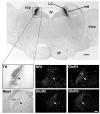Glutamate receptor subunit expression in the rhesus macaque locus coeruleus
- PMID: 17765206
- PMCID: PMC2067256
- DOI: 10.1016/j.brainres.2007.08.007
Glutamate receptor subunit expression in the rhesus macaque locus coeruleus
Abstract
The locus coeruleus (LC) is a major noradrenergic brain nucleus that regulates states of arousal, optimizes task-oriented decision making, and may also play an important role in modulating the activity of the reproductive neuroendocrine axis. Rodent studies have shown that the LC is responsive to glutamate receptor agonists, and that it expresses various glutamate receptor subunits. However, glutamate receptor subunit expression has not been extensively examined in the primate LC. We previously demonstrated expression of the NR1 NMDA glutamate receptor subunit in the rhesus macaque LC and now extend this work by also examining the expression of non-NMDA (AMPA and kainate) ionotropic glutamate receptor subunits. Using in situ hybridization histochemistry and immunohistochemistry, we confirmed the presence of the obligatory NR1 subunit in the LC. In addition, we demonstrated expression of the AMPA glutamate receptor subunits GluR1, GluR2, and GluR3. More extensive receptor profiling, using rhesus monkey gene microarrays (Affymetrix GeneChip), further corroborated the histological findings and showed expression of mRNA encoding ionotropic glutamate receptor subunits NR2A, NR2D, GluR4, and GluR6, as well as the metabotropic glutamate receptor subunits mGluR1, mGluR3, mGluR4, mGluR5, and mGluR7. These data provide a foundation for future examination of how changes in glutamate receptor composition contribute to the control of primate physiology.
Figures


References
-
- Aghajanian GK, Kogan JH, Moghaddam B. Opiate withdrawal increases glutamate and aspartate efflux in the locus coeruleus: an in vivo microdialysis study. Brain Res. 1994;636:126–130. - PubMed
-
- Agren H, Koulu M, Saavedra JM, Potter WZ, Linnoila M. Circadian covariation of norepinephrine and serotonin in the locus coeruleus and dorsal raphe nucleus in the rat. Brain Res. 1986;397:353–358. - PubMed
-
- Aston-Jones G, Shipley MT, Chouvet G, Ennis M, van Bockstaele E, Pieribone V, Shiekhattar R, Akaoka H, Drolet G, Astier B, et al. Afferent regulation of locus coeruleus neurons: anatomy, physiology and pharmacology. Prog Brain Res. 1991;88:47–75. - PubMed
Publication types
MeSH terms
Substances
Grants and funding
LinkOut - more resources
Full Text Sources

